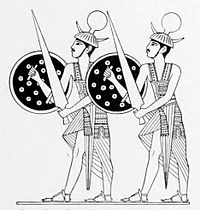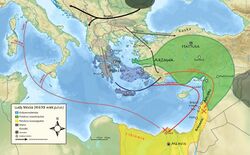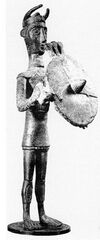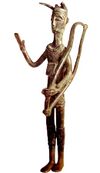Sherden
Topic: History
 From HandWiki - Reading time: 12 min
From HandWiki - Reading time: 12 min
The Sherden (Egyptian: šrdn, šꜣrdꜣnꜣ or šꜣrdynꜣ; Ugaritic: šrdnn(m) and trtn(m); possibly Akkadian: šêrtânnu; also glossed "Shardana" or "Sherdanu") are one of the several ethnic groups the Sea Peoples were said to be composed of, appearing in fragmentary historical and iconographic records (ancient Egyptian and Ugaritic) from the Eastern Mediterranean in the late 2nd millennium BC.
On reliefs, they are shown carrying round shields and spears, dirks or swords, perhaps of Naue II type. In some cases, they are shown wearing corslets and kilts, but their key distinguishing feature is a horned helmet, which, in all cases but three, features a circular accouterment at the crest. At Medinet Habu the corslet appears similar to that worn by the Philistines. The Sherden sword, it has been suggested by archaeologists since James Henry Breasted, may have developed from an enlargement of European daggers and been associated with the exploitation of Bohemian tin. Robert Drews suggested that use of this weapon by groups of Sherden and Philistine mercenaries made them capable of withstanding attacks by chariotry and so made them valuable allies in warfare,[1] but Drews's theory has been widely criticised by contemporary scholars.[2][3]
Early historical references
The earliest known mention of the people called Srdn-w, more usually called Sherden or Shardana, is generally thought to be the Akkadian reference to the "še-er-ta-an-nu" in the Amarna Letters correspondence from Rib-Hadda, mayor (hazannu) of Byblos,[4] to the Pharaoh Amenhotep III or Akhenaten in the 14th century BC. Though they have been referred to as sea raiders and mercenaries, who were prepared to offer their services to local employers, these texts do not provide any evidence of that association, and they shed no light on what the function of these "širdannu-people" was at the time.[5][6]
The first certain mention of the Sherden is found in the records of Ramesses II (ruled 1279-1213 BC), who defeated them in his second year (1278 BC) when they attempted to raid Egypt's coast. The pharaoh subsequently incorporated many of these warriors into his personal guard.[7] An inscription by Ramesses II on a stele from Tanis that recorded the Sherden pirates' raid and subsequent defeat, speaks of the constant threat which they posed to Egypt's Mediterranean coasts:
After Ramesses II succeeded in defeating the invaders and capturing some of them, Sherden captives are depicted in this Pharaoh's bodyguard, where they are conspicuous by their helmets with horns with a ball projecting from the middle, their round shields and the great Naue II swords,[10] with which they are depicted in inscriptions about the Battle of Kadesh, fought against the Hittites. Ramesses stated in his Kadesh inscriptions that he incorporated some of the Sherden into his own personal guard at the Battle of Kadesh.[11]
Years later, other waves of Sea People, the Sherden included, were defeated by Merneptah, son of Ramesses II, and Ramesses III. An Egyptian work written around 1100 BC, the Onomasticon of Amenope, documents the presence of the Sherden in Canaan.[12] After being defeated by Pharaoh Ramesses III, they, along with other "Sea Peoples", would be allowed to settle in that territory, subject to Egyptian rule.
The Italian orientalist Giovanni Garbini identified the territory colonized by the Sherden as that occupied, according to the Bible, by the Israelite tribe of Zebulun going by the eponym of Sared, which had established themselves in the northern territory of Canaan.[13][14][15] Archaeologist Adam Zertal suggests that some Sherden settled in what is now northern Israel. He hypothesizes that biblical Sisera was a Sherden general and that the archaeological site at el-Ahwat (whose architecture resembles nuraghe sites in Sardinia) was Sisera's capital, Harosheth Haggoyim,[16] though this theory has not received wide acceptance in the scholarly community.[17]
Connection to Sea Peoples
The Sherden seem to have been one of the more prominent groups of pirates that engaged in coastal raiding and the disruption of trade in the years around the 13th century BC. They are first mentioned by name in the Tanis II rhetorical stele of Ramesses II, which says in part, "As for the Sherden of rebellious mind, whom none could ever fight against, who came bold-hearted, they sailed in, in warships from the midst of the Sea, those whom none could withstand; but he plundered them by the victories of his valiant arm, they being carried off to Egypt."[18] It is possible that some of the Sherden captured in the battle recounted in Tanis II were pressed into Egyptian service, perhaps even as shipwrights or advisers on maritime technology, a role in which they may have assisted in the construction of the hybrid Egyptian warships seen on the monumental relief at Medinet Habu that shows the naval battle between Egyptians and Sea Peoples.[19]
Michael Wood has suggested that their raids contributed greatly to the collapse of the Mycenaean civilization.[20] However, while some Aegean attributes can be seen in the material culture of the Philistines, one of the Sea Peoples who established cities on the southern coastal plain of Canaan at the beginning of the Iron Age, the association of the Sherden with this geographic area is based entirely on their association with that group and the Sea Peoples phenomenon writ large, rather than on physical or literary evidence (of which almost all testifies to their presence in Egypt, rather than their port of origin).[21]
Origins
No mention of the Sherden has ever been found in Hittite or Greek legends or documents.[citation needed]
Eastern origin theory
English archaeologist Margaret Guido (1912–1994)[22] concludes the evidence for the Sherden, Shekelesh, or Teresh coming from the western Mediterranean is flimsy. Guido in 1963 suggests that the Sherden may ultimately derive from Ionia, in the central west coast of Anatolia, in the region of Hermos, east of the island of Chios. It is suggested that Sardis, and the Sardinian plain nearby, may preserve a cultural memory of their name.
Until recently it was assumed that Sardis was only settled in the period after the Anatolian and Aegean Dark Age, but American excavations have shown the place was settled in the Bronze Age and was a site of a significant population. If this is so, the Sherden, pushed by Hittite expansionism of the Late Bronze Age and prompted by the famine that affected this region at the same time, may have been pushed to the Aegean Islands, where shortage of space led them to seek adventure and expansion overseas. It is suggested that from here they may have later migrated to Sardinia. Guido suggests that
[if a] few dominating leaders arrived as heroes only a few centuries before Phoenician trading posts were established, several features of Sardinian prehistory might be explained as innovations introduced by them: Oriental types of armour, and fighting perpetuated in the bronze representation of warriors several centuries later; the arrival of the Cypriot copper ingots of the Serra Ilixi type; the sudden advance in and inventiveness of design of the Sardinian nuraghes themselves at about the turn of the first millennium; the introduction of certain religious practices such as the worship of water in sacred wells – if this fact was not introduced [later] by the Phoenician settlers.[23]
It has been stated that the only weapons and armour similar to those of the Sherden found in Sardinia have been dated to several centuries after the period of the Sea Peoples, which mainly covered the 13th–12th centuries BC. If the theory that the Sherden moved to Sardinia only after their defeat around 1178–1175 BC by Ramesses III is true, then it could be inferred from this that the finds in Sardinia are survivals of earlier types of weapons and armour.[dubious ] On the other hand, if the Sherden only moved into the Western Mediterranean in the ninth century, associated perhaps with the movement of early Etruscans and even Phoenician seafaring peoples into the Western Mediterranean at that time, this would solve the problem of the late appearance of their military gear in Sardinia; but it would remain unknown where they were located between the period of the Sea Peoples and their eventual appearance in Sardinia.
Western origin theory
The theory that postulates a migration of peoples from the Eastern Mediterranean to Sardinia during the Late Bronze Age was firmly rejected by Italian archaeologists like Antonio Taramelli[24] and Massimo Pallottino[25] and by Vere Gordon Childe,[26] and more recently by Giovanni Ugas, who instead identifies the Sherden with the indigenous Sardinian Nuragic civilization.[27][28][29] He excavated the accidentally-discovered Hypogeum of Sant'Iroxi in Sardinia, where several arsenical bronze swords and daggers dating back to 1600 BC were found. The discovery suggested that the Nuragic tribes actually used these kind of weapons since the mid-2nd millennium BC, as is also demonstrated by the Nuragic bronze sculptures dating back to as far as 1200 BC and depicting warriors with a horned helmet and a round shield.
Similar swords are also depicted on the statue menhir of Filitosa, in southern Corsica.[30] Giovanni Lilliu noted that the period in which the Sherden are mentioned in the Egyptian sources coincides with the height of the Nuragic civilization.[31] According to Robert Drews, Sardinians from the Gulf of Cagliari and the nearby areas were encouraged to become warriors and leave their island in order to improve their life conditions in the kingdoms of the Eastern Mediterranean.[32]
Since 2008, the "Shardana Project" has been developed in Corsica and Sardinia by the Centre of Studies J.-Fr. Champollion on Egyptology and Coptic Civilization, based in Genoa in cooperation with the University of Genoa and the University of the Mediterranean in Taranto. The project aims to gather as many data available about the Sherden culture inside and outside the Pharaonic Egypt.[33] The project, conducted by the Egyptologist Giacomo Cavillier, aims to verify the possible interconnections and contacts between the Sherden and the local culture of these islands, in a broader Mediterranenan view, and to reassess all data available on this phenomenon.[34]
The identification of the Sherden with the Nuragic Sardinians has also been supported by Sebastiano Tusa in his last book[35] and in its presentations,[36] and by Carlos Roberto Zorea, from the Complutense University of Madrid.[37]
Another one to support it has been the Cypriot archaeologist Vassos Karageorghis, that found Nuragic pottery in Cyprus and wrote about the Nuragic role in places like the Syrian city of Tell Kazel.
It is most probable that among the Aegean immigrants there were also some refugees from Sardinia. This may corroborate the evidence from Medinet Habu that among the Sea Peoples there were also refugees from various part of the Mediterranean, some from Sardinia, the Shardana or Sherden. [...] It is probable that these Shardana went first to Crete and from there they joined a group of Cretans for an eastward adventure.[38]
Adam Zertal, and more recently Bar Shay from Haifa University, have also argued that the Shardana were Nuragic Sardinians, and connected them to the site of El-Awat in Canaan.
When you look at plans of sites of the Shardana in Sardinia, in the second millennium BCE, throughout this entire period, you can see wavy walls, you can see corridors... you can see high heaps of stones, which were developed into the classical nuraghic culture of Sardinia. The only good architectural parallels are found in Sardinia and the Shardana culture[39]
According to Malcolm H. Wiener "some of the Sea Peoples are likely to have started from Sardinia, Sicily, Italy, or the Balkans. Sardinia has long been viewed as a likely or possible homeland of the Sherdana in light of the similarity in names and Egyptian depictions of helmets resembling helmets found in Sardinia" while for the Austrian archeologist Reinhard Jung "the hypothesis of a connection between Šardana and Nuragic Sardinians is as old as the archaeology, but it could not be proven so far." (2017).[40]
Late Bronze Age Nuragic pottery had been found in the Aegean and in the Eastern Mediterranean particularly in Crete at Kommos and on the island of Cyprus, at Kokkinokremnos, a site attributed to the Sea Peoples,[41][42] and Hala Sultan Tekke.[40] Nuragic pottery were also found in a tomb of the Ugarit harbour of Minet el-Beida.[43]
See also
- Paleo-Sardinian language
- List of ancient Corsican and Sardinian tribes
- History of Sardinia
References
- ↑ Drews, Robert (1993). The End of Bronze Age. Princeton University Press.
- ↑ Cline, Eric H. (1997). "Review of Robert Drews' 'The End of the Bronze Age: Changes in warfare and the catastrophe ca. 1200 B.C.'". Journal of Near Eastern Studies 56 (2): 127–129. doi:10.1086/468535.
- ↑ Dickinson, Oliver T.P.K. (1999). Laffineur, R.. ed. Polemos: Le Contexte Guerrier en Egee a l'Age du Bronze. Aegaeum. 19. Universite de Liege. pp. 21–25.
- ↑ EA 81, EA 122, EA 123 in Moran (1992) pp. 150-151, 201-202[full citation needed]
- ↑ Emanuel, Jeffrey P. (2013). "Sherden from the Sea: The arrival, integration, and acculturation of a Sea People". Journal of Ancient Egyptian Interconnections 5 (1): 14–27. doi:10.2458/azu_jaei_v05i1_emanuel. https://www.academia.edu/2445831.
- ↑ Emanuel, Jeffrey P. (2012). "Šrdn of the Sea: A reassessment of the Sherden and their role in Egyptian Society". AIA annual meeting. https://www.academia.edu/1716287.
- ↑ Grimal, N.. A History of Ancient Egypt. pp. 250–253.
- ↑ Kitchen, Kenneth (1982). Pharaoh Triumphant: The life and times of Ramesses II, King of Egypt. Aris & Phillips. pp. 40–41.
- ↑ Cavillier, Giacomo (2008). "Gli shardana e l'Egitto ramesside". BAR (Oxford, UK: Archaeopress) (1438).
- ↑ Gardiner 1968: 196-197
- ↑ Battle Inscriptions in Lichtheim 1976: 63ff[full citation needed]
- ↑ Giovanni Garbini, cit., p. 52[full citation needed]
- ↑ cf. Garbini, G., I Filistei, Rusconi, Milano, 1997: passim
- ↑ Contu 2001 b/37-38 and 41-45
- ↑ Contu 2002: 537 and 546-547
- ↑ "Archaeological mystery solved". University of Haifa. July 1, 2010. http://newmedia-eng.haifa.ac.il/?p=3309.
- ↑ Emanuel, Jeffrey P. (2012–2013). "Review of Adam Zertal (ed.), 'El-Ahwat: A fortified site from the early Iron Age near Nahal' Iron, Israel: Excavations 1993-2000". Journal of Ancient Egyptian Interconnections (Brill) 5 (2): 57–60. https://www.academia.edu/3100219.
- ↑ Kitchen, Kenneth A. (1996). Ramesside Inscriptions Translated and Annotated. II: Translations: Ramesses II, Royal Inscriptions. Cambridge: Wiley. p. 120 §73.
- ↑ Emanuel, Jeffrey P. (2014). "The Sea Peoples, Egypt, and the Aegean: Transference of maritime technology in the late Bronze–early Iron transition (LH IIIB–C)". Aegean Studies 1: 21–56. https://www.academia.edu/5303290.
- ↑ Wood, Michael (1987). In Search of the Trojan War. BBC Books. ISBN 0452259606.
- ↑ Emanuel, Jeffrey P. (2012). "Šrdn of the strongholds, Šrdn of the Sea: The Sherden and their role in Egyptian society, reassessed". American Research Center in Egypt annual meeting. https://www.academia.edu/1716293.
- ↑ Guido, Margaret (1963). The Sardinians. People and Places. Thames Books.
- ↑ Guido, Margaret. The Sardinians. pp. 187–188.
- ↑ Taramelli, Antonio (1982) (in it). Scavi e scoperte. 1903-1910. Sassari: Carlo Delfino editore. OCLC 643856632. "Ma io ritengo che le conseguenze della nostra osservazione sulla continuità degli elementi eneolitici in quelli della civiltà nuragica abbiano una portata maggiore di quella veduta dal collega mio; che cioè la civiltà degli Shardana siasi qui elaborata completamente, dai suoi germi iniziali, sia qui cresciuta, battagliera, vigorosa, e che lungi dal vedere nella Sardegna l'estremo rifugio di una razza dispersa, inseguita, come una fiera fuggente, dall'elemento semitico che venne qui ad azzannarla e a soggiogarla, noi dobbiamo vedere il nido donde essa spiegò un volo ardito, dopo aver lasciato una impronta di dominio, di lotta, di tenacia, sul suolo da lei guadagnato alla civiltà."
- ↑ Pallotino, Massimo. La Sardegna Nuragica. p. 119.
- ↑ Gordon Childe, Vere (1930). The Bronze Age. https://www.marxists.org/archive/childe/1930/bronzeage/ch06.htm. "In the nuragic sanctuaries and hoards we find an extraordinary variety of votive statuettes and models in bronze. Figures of warriors, crude and barbaric in execution but full of life, are particularly common. The warrior was armed with a dagger and bow-and-arrows or a sword, covered with a two-horned helmet and protected by a circular buckler. The dress and armament leave no doubt as to the substantial identity of the Sardinian infantryman with the raiders and mercenaries depicted on Egyptian monuments as "Shardana". At the same time numerous votive barques, also of bronze, demonstrate the importance of the sea in Sardinian life."
- ↑ Ugas, Giovanni (2016). Shardana e Sardegna. I popoli del mare, gli alleati del Nordafrica e la fine dei Grandi Regni. Cagliari, Edizioni Della Torre.
- ↑ "Nuovo studio dell'archeologo Ugas". 3 February 2017. http://www.sardiniapost.it/culture/nuovo-studio-dellarcheologo-ugas-e-certo-i-nuragici-erano-gli-shardana/. "“È certo, i nuragici erano gli Shardana.”"
- ↑ "Giovani Ugas: Shardana" (in IT). http://www.sardiniapoint.it/5085.html.
- ↑ Ugas, Giovanni (2005). L'alba dei Nuraghi.
- ↑ Lilliu, Giovanni. La Civiltà Nuragica. p. 111.
- ↑ Drews, Robert (1993). The End of the Bronze Age: Changes in warfare and the catastrophe ca. 1200 BC. Princeton, NJ: Princeton University Press. pp. 218-219. https://archive.org/details/endbronzeage00drew.
- ↑ Cavillier, G. (2003). "Gli Shardana dell'Egitto o l'Egitto degli Shardana: la visione del mercenario nell'Egitto ramesside". Aegyptus LXXXII: 67–80.
- ↑ Cavillier, Giacomo (2010). "Shardana Project: Perspectives and researches on the Sherden in Egypt and Mediterranenan". Syria 87 (87): 339–345. doi:10.4000/syria.695.
- ↑ Tusa, Sebastiano (2018) (in it). I popoli del Grande Verde : il Mediterraneo al tempo dei faraoni. Ragusa: Edizioni Storia e Studi Sociali. ISBN 9788899168308. OCLC 1038750254.
- ↑ Presentazione del libro "I Popoli del Grande Verde" di Sebastiano Tusa presso il Museo del Vicino Oriente, Egitto e Mediterraneo della Sapienza di Roma, (in italiano). 2018-03-21. Event occurs at 12:12.
- ↑ Zorea, Carlos Roberto (2021). Sea peoples in Canaan, Cyprus and Iberia (12th to 10th centuries BC). Madrid: Complutense University of Madrid. https://eprints.ucm.es/id/eprint/65302/1/T42277.pdf.
- ↑ Karageorghis, Vassos (2011). "Handmade Burnished Ware in Cyprus and elsewhere in the Mediterranean" (in en). On cooking pots, drinking cups, loomweights and ethnicity in bronze age Cyprus and neighbouring regions: an international archaeological symposium held in Nicosia, November 6th-7th, 2010. A.G. Leventis Foundation. p. 90. ISBN 978-9963-560-93-6. OCLC 769643982.
- ↑ "Archaeological site could cast light on life of Biblical Villain Sisera" (in en-US). 2019-11-27. https://www.jpost.com/israeli-life-in-docs/archaeological-site-could-cast-light-on-life-of-biblical-villain-609189.
- ↑ 40.0 40.1 Peter M. Fischer and Teresa Bürge, ed. (2017), Sea Peoples" Up-to-Date: New Research on Transformation in the Eastern Mediterranean in 13th-11th Centuries BCE, https://www.researchgate.net/publication/345713228_Sea_Peoples_Up-to-Date_New_Research_on_Transformation_in_the_Eastern_Mediterranean_in_13th-11th_Centuries_BCE, retrieved 24 November 2023
- ↑ Karageorghis, V.; Karageorghis, J. (2013). "L´Isola di Afrodite". Archeologia Viva (159): 40–53.
- ↑ Gale, N.H. (2011). "Source of the lead metal used to make a repair clamp on a Nuragic vase recently excavated at Pyla-Kokkinokremos on Cyprus". On Cooking Pots, Drinking Cups, Loomweights and Ethnicity in Bronze Age Cyprus and Neighbouring Regions. Nicosia.
- ↑ Ioanna Kostopoulou, Reinhard Jung, Observations on the Pottery of the 2014-2019 Campaigns, https://www.academia.edu/resource/work/105519232, retrieved 10 October 2023
Bibliography
- Giovanni Garbini, I Filistei. Gli antagonisti di Israele, Rusconi, Milano, 1997
- N. K. Sandars (1987) (in en). The Sea Peoples: Warriors of the ancient Mediterranean (edizione riveduta ed.). London: Thames and Hudson. https://archive.org/details/seapeopleswarrio00sand.
- Ugas, Giovanni (2016) (in it). Shardana e Sardegna : i popoli del mare, gli alleati del Nordafrica e la fine dei Grandi Regni (XV-XII secolo a.C.). Cagliari: Edizioni della Torre. ISBN 9788873434719. OCLC 976013893.
- Tusa, Sebastiano (2018) (in it). I popoli del Grande Verde : il Mediterraneo al tempo dei faraoni. Ragusa: Edizioni Storia e Studi Sociali. ISBN 9788899168308. OCLC 1038750254.
- Mohamed Raafat Abbas, “A Survey of the Military Role of the Sherden Warriors in the Egyptian Army during the Ramesside Period”, Égypte Nilotique et Méditerranéenne 10 (2017), p. 7–23.
External links
- Academic papers on the Sherden, a resource of peer-reviewed publications and lectures that deal with, or relate to, the Sherden.
- The Amarna letters, letters written in Akkadian and found at el-Amarna in Egypt, of which three (EA 81, 122, 123) may mention the Sherden.
- Interview with Giovanni Ugas (in Italian)
- The Papyrus Harris
- Review of relevant literature with links to some (translated) original sources
- The Sea People (in English)
- Sources and discussion about the Sherden (in Italian)
 |
 KSF
KSF





